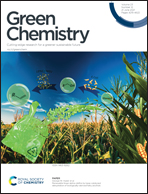One-pot synthesis of enzyme@metal–organic material (MOM) biocomposites for enzyme biocatalysis†
Abstract
Metal–organic frameworks/materials (MOFs/MOMs) are advanced enzyme immobilization platforms that improve biocatalysis, materials science, and protein biophysics. A unique way to immobilize enzymes is co-crystallization/co-precipitation, which removes the limitation on enzyme/substrate size. Thus far, most enzyme@MOF composites rely on the use of non-sustainable chemicals and, in certain cases, heavy metals, which not only creates concerns regarding environmental conservation but also limits their applications in nutrition and biomedicine. Here, we show that a dimeric compound derived from lignin, 5,5′-dehydrodivanillate (DDVA), co-precipitates with enzymes and low-toxicity metals, Ca2+ and Zn2+, and forms stable enzyme@Ca/Zn–MOM composites. We demonstrated this strategy on four enzymes with different isoelectric points (IEPs), molecular weights, and substrate sizes. Furthermore, we found that all enzymes displayed slightly different but reasonable catalytic efficiencies upon immobilization in the Ca–DDVA and Zn–DDVA MOMs, as well as reasonable reusability in both composites. We then probed the structural basis of such differences using a representative enzyme and found enhanced restriction of enzymes in Zn–DDVA than in Ca–DDVA, which might have caused the activity difference. To the best of our knowledge, this is the first aqueous-phase, one-pot synthesis of a lignin-derived “green” enzyme@MOF/MOM platform that can host enzymes without any limitations on enzyme IEP, molecular weight, and substrate size. The different morphologies and crystallinities of the composites formed by Ca–DDVA and Zn–DDVA MOMs broaden their applications depending on the problem of interest. Our approach of enzyme immobilization not only improves the sustainability/reusability of almost all enzymes but also reduces/eliminates the use of non-sustainable resources. This synthesis method has a negligible environmental impact while the products are non-toxic to living things and the environment. The biocompatibility also makes it possible to carry out enzyme delivery/release for nutritional or biomedical applications via our “green” biocomposites.

- This article is part of the themed collection: Biocatalysis: A cross-journal collection


 Please wait while we load your content...
Please wait while we load your content...